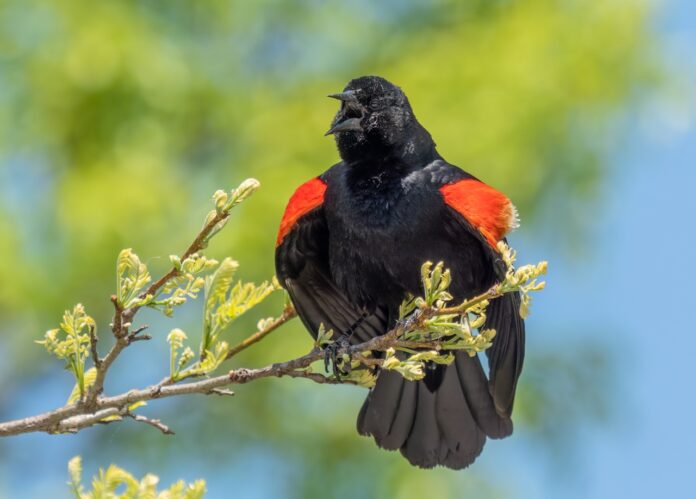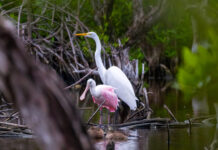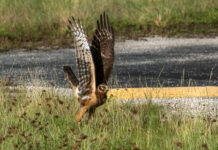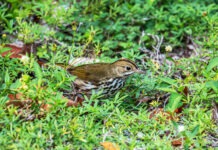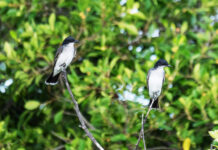Red-winged blackbirds vexed me when I first started birding. Not the males. They’re easy. They have that sleek all-black plumage, accented by those nominate red and non-nominate yellow epaulets, which generally makes them look all shipshape and Bristol fashion. (This sense of military orderliness is only enhanced by the fact that their three-note call is similar to the tune of the boatswain’s whistle on “Star Trek.”)
Male red-winged blackbirds are a study in effectively simple design, but also in obviousness.
We used to have this window in our living room that was covered by our neighbor’s bougainvillea, which was fine because they weren’t the kind of neighbors you want to see anyhow. But the backside of the bougainvillea, framed by the window, looked something like a diorama, or one of those pens at a zoo designed to look like natural habitat. Mostly it was an empty tableau, but occasionally it was inhabited by these plain brown birds whose most distinctive feature was a long (for a songbird) pointed bill, and some brown streaks in their chest. They seemed designed to confuse with their vague, non-distinct birdness.
This was in my early birding days. It took me several flips through the bird book to figure out what I was seeing. And then I’d forget by the next time I saw them.
And, yes, they were female red-winged blackbirds. They just looked nothing like their male counterparts. This throws a lot of birders in their early days.

Bird species having sexually dimorphic plumage is not rare. In a solid 10 minutes of Googling I couldn’t find a statistic for dimorphic versus monomorphic plumage, but an impatient survey of my Sibley field guide makes me think about 30% to 40% of bird species in North America have sexually dimorphic plumage. (This should all be asterisked by the fact that birds see in a wider color spectrum than we do. So who knows what we’re missing?)
The dynamic of males being more eye-catching than females in dimorphic species is thought to be because males need to be flashier, with a higher risk of visibility to predators, in order to show their reproductive fitness. And also to scare other males out of their territory. Females, being less conspicuous, incur less risk, and therefore are more likely to survive, at least long enough to raise offspring.
Humans tend to admire monogamy in birds. How many sentimental poems have been written about swans and their lifelong devotion to each other? Though it is not as lifelong as many people think, with about a 10% divorce rate. And if a female loses her mate, she’ll sometimes find a new one in as little as three weeks. Other monogamous species are often only monogamous for a season.
None of that matters to red-winged blackbirds. They have no time for that truck. Because honestly, social structure-wise, they’re pretty freaky.
The technical term is polygynous — one male has multiple female mates.
Red-winged blackbirds are considered colonial breeders, but males will hold territory within those colonies, and will breed with one to four females within those territories. (The record of observed females in a red-wing harem – not my term – is 15.)
Males can make their epaulets more prominent and less prominent. They use their epaulets (properly called lesser coverts) to intimidate each other. In one study, in which a group of red-wings had their epaulets dyed black, the birds lost their territories 60% more often than red-wings with unadulterated epaulets. In another study, taxidermied birds were placed in the male red-wing’s breeding territories, with epaulets completely blackened, half-blackened, left untouched, or augmented with the epaulets of other taxidermied birds. The bigger their epaulets, the more the stuffed birds were attacked by territorial males.
Male red-wings also use their adornments to pitch woo. In the general mating ritual, the male will crouch, sing a chit-chit-chit song, flash some vibrating epaulets and approach the female. If she’s game, she will hold her body horizontal, or maybe angle down some, and raise her tail a bit.
An epic interval of romantic pleasure will follow. By which I mean a two- to three-second cloacal kiss. The male may then sing some and act aggressively toward any other birds around, no matter their sex.
At the beginning, the males will make a visual show of helping build the nest, grabbing a loose twig or two, but the female will build the whole thing, sometimes within a single day. While she’s doing that she will lose a small tract of feathers in her belly to create a brood patch in order to help incubate the eggs.
Unlike a lot of species, after the donation of his genetic material, the male does not go out for a pack of cigarettes and never come back. While the female incubates, he will find a high perch and sing. The song will convey that it is his territory, but also the threat level of predators. The female will sometimes sing back. When the chicks hatch, they both feed them.
Among the potential predators are owls, hawks, minks and raccoons. And sometimes marsh wrens who, because they are apparently little psychos, like to poke holes in the eggs of any other songbirds nesting near them, including other marsh wrens. (There are no marsh wrens in the Keys.)
Fortunately, red-winged blackbirds, if the alarm goes out, will gang up – both males and females, often from different territories – and mob whatever or whoever they see as a threat. Including the occasional bald eagle.
The whole polygyny thing may seem bleakly patriarchal, but that’s not really the case. Female red-wings participate in a lot of EPCs, or extra-pair copulations, sometimes with males from neighboring territories, sometimes with males known as floaters – birds that have given up on their inferior territories, or periodically, birds that are just inclined to live as territory-less avian rolling stones.
Polygynous species often have a lower ratio of males to females, but the sex ratio is close to even for red-wings with, on average, nine males born for every 10 females. Between 6% and 18% percent of observed copulations are considered to be EPCs. Which doesn’t necessarily mathematically jibe with the near-even sex ratio. But genetic testing shows that up to 40% of chicks hatched come from EPCs. Meaning females may be more discreet and on the down-low than humans have been able to observe.
Red-winged blackbirds are pretty widely distributed across North America and Mexico, as well as the Bahamas and about half of Cuba. There are about 20 subspecies with one, Agelaius phoeniceus floridanus, living in the range of South Florida and the Keys.
Interestingly, the way you can distinguish it is the belly and throat of the female is whiter than the other subspecies.












